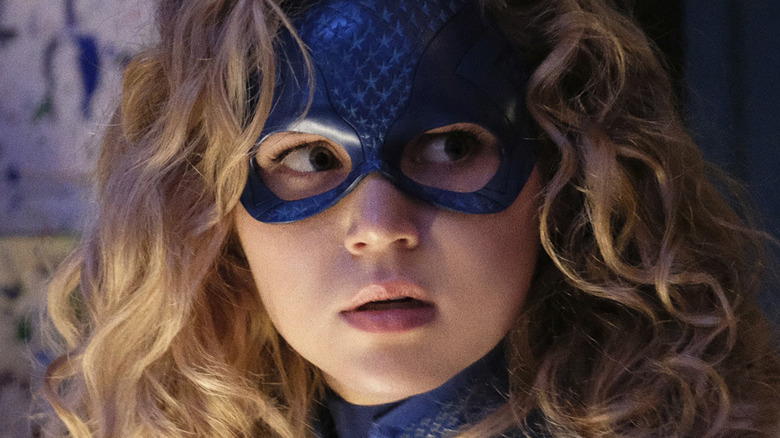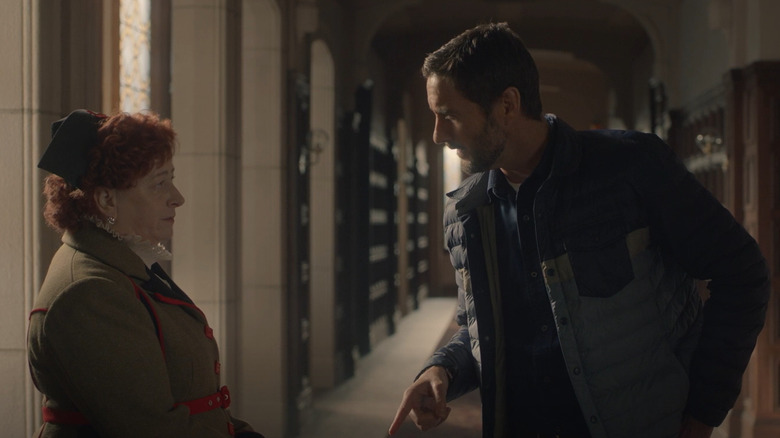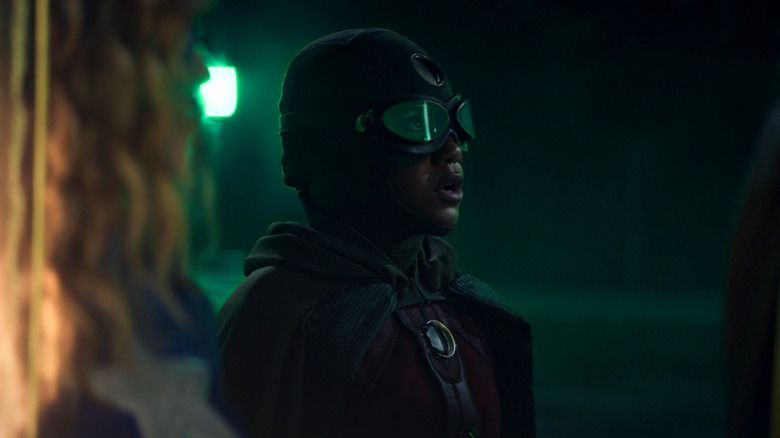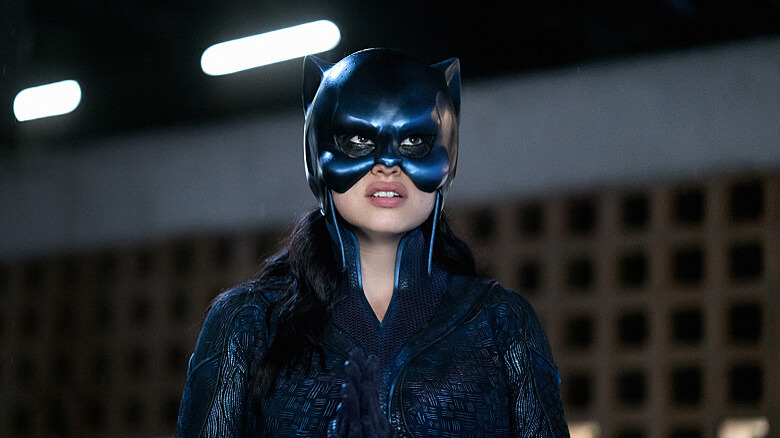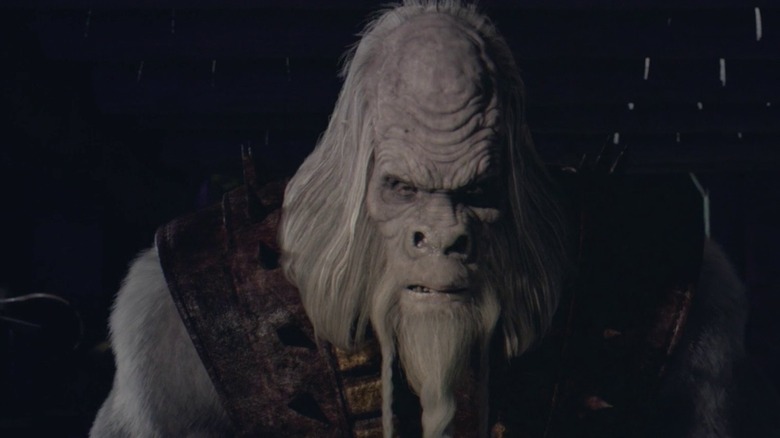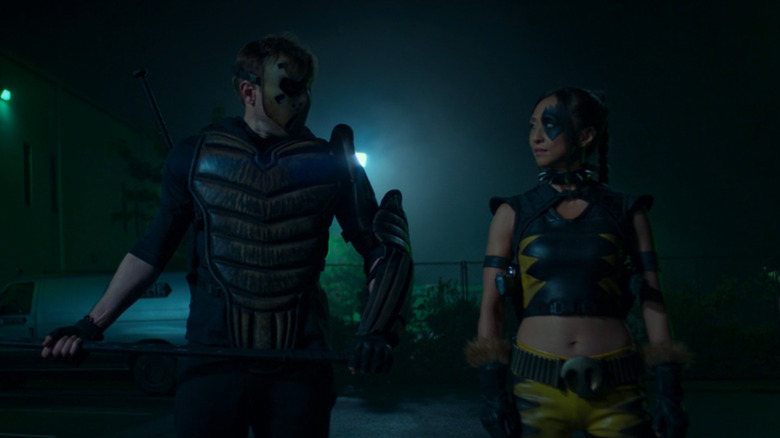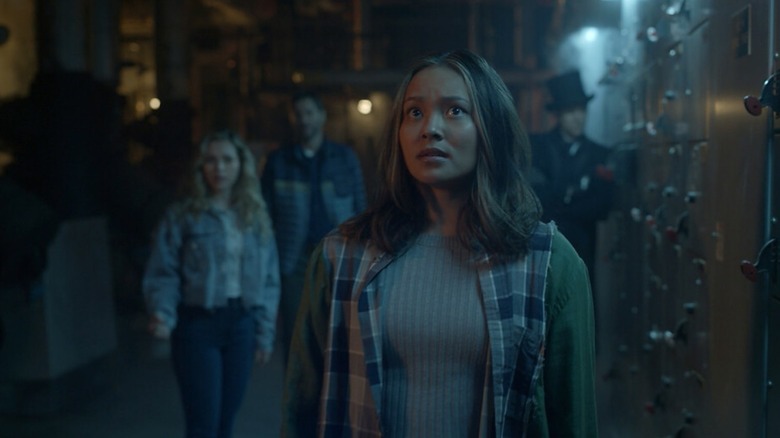Small Details You Missed In DC's Stargirl Season 3
"DC's Stargirl" debuted alongside series like "Titans" and "Doom Patrol" on the short-lived DC Universe app. The platform once housed several shows, most of which moved to other networks when it changed its name to DC Universe Infinite and became solely a comic book archive. "Stargirl" made the jump to The CW, where it quickly became a fan (and a critical) favorite. While creator Geoff Johns had a fourth season in mind ("Someday I'll talk about it," he told TV Line), the network let him know in advance that Season 3 would be the final season, so he was able to alter the outline accordingly and give the title character a better send off.
The "Stargirl" story follows Courtney Whitmore (Brec Bassinger) as she discovers the Cosmic Staff. She chooses to use her newfound power — and the knowledge that her stepfather Pat is S.T.R.I.P.E., the former robotic-suit-wearing sidekick of the superhero Starman — to become a hero herself. After finding other classic, power-granting items belonging to the old Justice Society of America, she helps kickstart a new generation of heroes.
This is a series that thrives by allowing some of the company's most obscure characters to be granted new life through a modern lens, so it's no surprise that Easter eggs are abound throughout its 39 episodes. The third season of "DC's Stargirl" pulls out all the stops with its nods to classic continuity and pop culture in general. Here are some small details you may have missed. Spoilers ahead.
Nods to classic murder mysteries
One of the central ideas behind "Stargirl" was to bring in different genre themes to influence the direction of each season. "The first season was a coming of age superhero story in the same vein of a lot of movies I loved growing up, like 'Karate Kid' and 'Back to the Future,'" Geoff Johns told TV Line. "The second season was more horror based, inspired by films like 'Nightmare on Elm Street' and 'Flatliners.'" For its final round of episodes, "Stargirl" went with a no-holds-barred murder mystery. With clever flashbacks and nods to noir films of days gone by, the overall vibe is Agatha Christie meets DC comics.
When Will Sharpe, the Gambler, returns to Blue Valley after tormenting the heroes in prior episodes, they're torn by his insistence that he is there to uncover the truth about the daughter he never knew he had. He's also hoping to make amends for his past actions. Several key characters doubt this sudden change of heart, but it becomes a moot point when he is murdered by an unknown assailant. This puts our crew in the position of having to do some Hercule Poirot-style detective work, digging deep into the past and considering the motivations of everyone present.
Geoff Johns has revealed that the film "Knives Out" was a big inspiration for Season 3. The film proved that audiences were eager for murder mysteries, and the DC man knew the time was right to launch his. "It was always important to have the murder mystery for this specific season because it was an issue of trust at a time when you were learning how to trust people," Johns told CBR.
Dr. Mid-Nite's goggles are now practical
Although all the characters underwent extensive growth over the run of the series, there is something to be said for the unique journey of Beth Chapel, otherwise known as Dr. Mid-Nite. Starting the series as an incredibly smart girl who was treated as an outcast by her peers, she became one of the most important characters after donning the superpowered goggles of the original Mid-Nite.
Fans already knew that Beth's impressive glasses have some incredible abilities and have saved the day many times over, but the third season saw the introduction of a real-world feature that proved to be game-changing for one cast member. The goggles, once made to light up in post-production, were given an actual light. Only the most eagle-eyed viewers will have noticed the introduction of these new, functioning goggles. "As I wear them, they light up on their own," actor Anjelika Washington told "The Stargirl Aftershow." "I love it. I think it's the coolest thing. The day they brought them to me, I cried real tears."
The Nathaniel Dusk Easter egg
This Easter egg is perfectly in tone with the noir-inspired third season of "DC's Stargirl." If you noticed the references to Nathaniel Dusk and were wondering who that is, we've got you covered. Obscure even by classic comic book standards, Dusk isn't super well-known, particularly if you skipped the "Doomsday Clock" comics, where he plays a vital role.
Introduced as a hard-boiled detective in the mid 1980s, the character is best-known for a pair of four-issue miniseries that play on classic pulp fiction. In "Doomsday Clock," his story is a meta one: We discover that the character is actually fictional in-universe and he's the star of his own franchise. He's portrayed by an actor named Carver Colman, who is discovered bludgeoned to death in his own home. The murder weapon is an award won by the actor.
Dusk's status as a noir detective is intact in the series, but there are some key elements of his history that have been changed. In "Stargirl," Nathaniel Dusk is a marquee name dropped casually into the background, gracing movie posters in Blue Valley. In classic Nathaniel Dusk form, he's more of a footnote than a crucial plot element here. Nevertheless, the presence of his name helps to set the tone of the scene and of the season in general.
Crock's alias is a nod to the creator of Wildcat
Larry Crock went from being a two-bit crook in the employ of Will Sharpe to one of the most vital characters in the show pretty quickly, siding with the Injustice Society of America under the moniker Sportsmaster. One small detail you may have missed about the character is his name, which has a comic book history stretching back decades. As only the most hardcore of DC fans will know, an antagonist by the name of Lawrence "Crusher" Crock appeared in 1947's "All-American Comics Vol 1" #85, introduced as a gifted sportsman who turned to crime after a series of setbacks. He was co-created by the late Irwin Hasen. If that name sounds familiar, it's because Crock actually uses it as an alias in the show during a wonderfully meta moment.
The reference occurs in the third episode of Season 3, "The Blackmail." A wire transfer made to Will Sharpe is identified as coming in from one Irwin Hasen, which we quickly learn is none other than Larry Crock. Though often relegated to footnote status in the larger DC comics story, Hasen also created the character Ted Grant (aka the Wildcat), thereby providing inspiration for Yolanda in "Stargirl." Sadly, Hasen is no longer around to enjoy these small nods to his work — the veteran comic book creator passed away in 2015 aged 96.
The Ultra-Humanite is more important than you think
One of the major players in "Stargirl" Season 3 is the ape-like Ultra-Humanite, whose journey in the show relies on a lot of plot twists and brain-swapping antics. What well-versed viewers may know is that the Ultra-Humanite is actually the first legit superpowered villain faced by Superman, debuting in "Action Comics #13" in 1939 . A historically important character in DC comics lore, he predates Lex Luthor by several months and was Superman's first arch-nemesis. He means business in his debut appearance, too: He ties Superman to a plank and feeds him into a sawmill at one stage.
Though Ultra-Humanite has not entered the public consciousness in the same way as villains like Lex Luthor and the Joker have, he's still got a truly bonkers history behind him that might come as a bit of a shock to fans of "Stargirl." Though he's undergone several iterations throughout his time, he has remained a favorite of creators, taking on an adversarial role for both the JLA and the JSA. While he might never be famous outside of dedicated DC circles, there's still something pretty alarming about an engineered, ape-like body inhabited by a mad scientist hellbent on world domination.
Tigress and Sportsmaster's relationship has improved
In Season 1, it seemed pretty unlikely that Sportsmaster (Larry Crock) and Tigress (Paula Brooks) would go from hired villains working for Will Sharpe to being main cast members, but that's exactly what happened. Both characters were promoted to the regular cast for the third season, and Season 3 was all the better for it. However, there's no huge introduction. It's done in an understated way, which makes their more prominent roles feel natural.
Despite serving with the Injustice Society of America, Larry and Paula are also a loving couple that wants the best for their daughter. They're required to occasionally become temporary do-gooders to make sure that happens. The third season sees some major changes in their lives as they leave crime behind, possibly forever. By the time we leave them in the final episode during a meal with their neighbors Pat and Barbara, observant viewers will have noticed that their relationship is thriving.
During the meal, we learn that they've both taken to being heroes. They drop in the fact that this has actually bettered their love life, which causes the other couple to quickly ask for the check. It's good to see them doing well, even if they haven't always been on the side of the good guys.
The Infinity Inc. two-parter is full of DC nods and Easter eggs
It's a shame that "DC's Stargirl" won't go beyond three seasons, because Season 3 was clearly setting up the future of the show — and perhaps even some spinoffs, too. Following up on the second season introduction of Jade, the daughter of Golden Age Green Lantern Alan Scott, the "Infinity Inc." two-parter introduced a slew of new characters. In true "Stargirl" fashion, both episodes were full to the brim with obscure nods and callbacks to the expansive history of DC comics.
Infinity Inc. is the name of a team of superheroes introduced in the early 1980s by creators Roy Thomas, Jerry Ordway, and Mike Machlan. They were hoping to modernize the classic Justice Society of America, so they came up with a younger team made up mainly of the kids of JSA members. Perhaps the biggest Easter egg in this two-part episode is the mention of Sandy Hawkins, who Jade leaves to meet up with. We'll likely never know what comes of this meeting, but Hawkins is one of DC's oldest characters, introduced back in 1941 as the sidekick of the original Sandman.
Recognizable names in the credits
Did you catch Lea Thompson's name in the credits? It's a small detail, but one that genre fans no doubt noticed. With early starring roles in films like "Howard the Duck," "Red Dawn," and "Back to the Future," Thompson helped to define an influential era of sci-fi. Since then, she's stayed busy doing everything from sitcoms to period dramas. Her influence on genre TV and film remains strong: She has shifted her focus to directing in recent years, taking the helm for episodes of "Resident Alien," "Star Trek: Picard," and, of course, "Stargirl."
Having worked on the first two seasons of "DC's Stargirl," Thompson returned to direct Season 3 episodes "The Thief" and "The Betrayal." They are two of the most pivotal episodes of the season. "The Thief" follows a series of break-ins and sees our heroes attempting to gain insight into Sharpe's death. "The Betrayal" sees the core group of friends at the show's heart experiencing serious turmoil as Courtney's relationship with Cameron becomes more serious.
Another name that only hardcore fans are likely to spot in the credits is that of James Robinson, a writer on the series. If you're familiar with DC comics, then you'll know that Robinson was perfect for the role, because he helped revive the Justice Society of America during his run on the title in the 1990s. In fact, he co-created the Jack Knight version of Starman.
